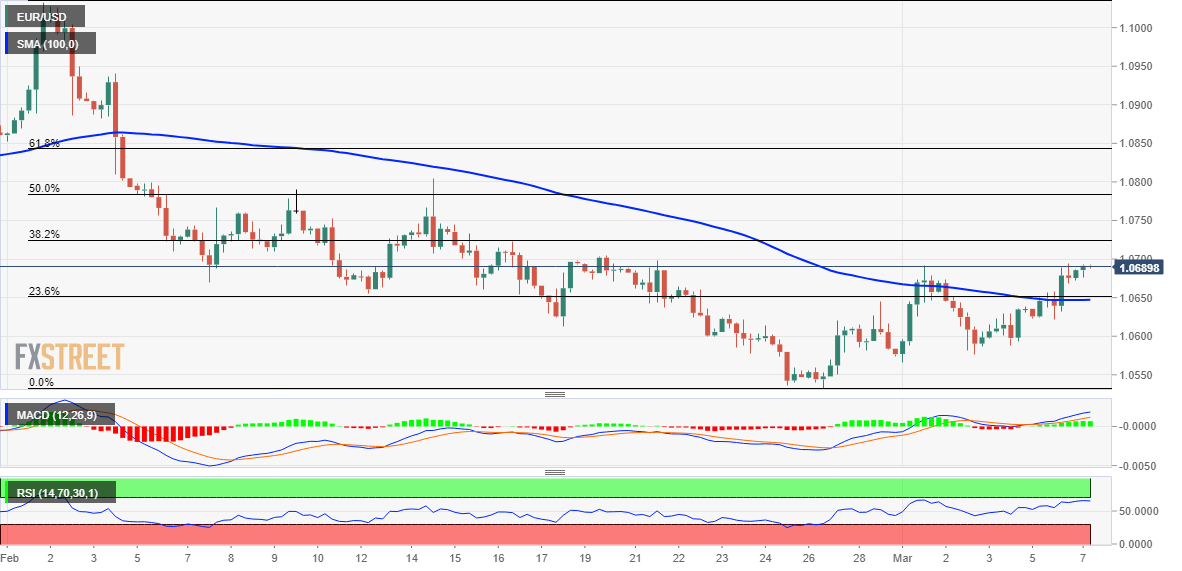- EUR/USD sticks to modest gains near a two-week high through the Asian session on Tuesday.
- The overnight hawkish commentary by ECB officials underpins the Euro and acts as a tailwind.
- A positive risk tone weighs on the safe-haven USD and lends additional support to the major.
- The upside seems limited as investors look forward to Fed Chair Jerome Powell’s testimony.
The EUR/USD pair holds steady near a two-week high, just below the 1.0700 mark through the Asian session on Tuesday and is supported by a combination of factors. The shared currency is underpinned by more hawkish comments by several European Central Bank (ECB) members, backing the case for additional jumbo rate hikes in the coming months. In fact, ECB President Christine Lagarde reiterated on Monday that the central bank is set to raise borrowing costs by another 50 bps at its upcoming meeting on March 16. Separately, Austrian Central Bank Governor Robert Holzmann said that the ECB should raise rates by 50 bps at each of its next four meetings in March, May, June and July. This, in turn, pushes the yield on the rate-sensitive two-year German bond to its highest level since October 2008 and continues to benefit the common currency. Apart from this, a generally positive tone around the equity markets is seen weighing on the safe-haven US Dollar and lending additional support to the major.
The USD downtick, however, seems limited amid elevated US Treasury bond yields, bolstered by expectations for further policy tightening by the Federal Reserve (Fed). The incoming US macro data indicated that inflation isn't coming down quite as fast as hoped and pointed to an economy that remains resilient despite rising borrowing costs. This should allow the US central bank to stick to its hawkish stance and continue raising interest rates for longer. Furthermore, a slew of FOMC policymakers recently backed the case for higher rate hikes and opened the door for a 50 bps lift-off at the March policy meeting. Hence, the market focus will remain glued to Fed Chair Jerome Powell's semi-annual congressional testimony on Tuesday and Wednesday. Investors will look for clues about the Fed's future rate-hike path, which will play a key role in influencing the near-term USD price dynamics. In the meantime, looming recession risks should act as a tailwind for the buck and cap the upside for the EUR/USD pair.
Investors this week will also confront the release of the closely-watched US monthly employment details, popularly known as NFP on Friday. This should further contribute to providing some meaningful impetus to the EUR/USD pair and help determine the next leg of a directional move. Hence, it will be prudent to wait for strong follow-through buying before confirming that the pair has formed a bottom near the 1.0535-1.0530 region and that the recent pullback from a multi-month peak touched in February has run its course.
Technical Outlook
From a technical perspective, the overnight sustained strength and acceptance above the 1.0645-1.0650 confluence hurdle favour bullish traders. Moreover, oscillators on the daily chart have just started moving in the positive territory and support prospects for additional gains. Any further move up, however, might confront some resistance near the 38.2% Fibo. level, around the 1.0725 zone. The next relevant barrier is pegged near the 1.0760 horizontal zone ahead of the 50% Fibo. level, around the 1.0785 region and the 1.0800 round-figure mark. Some follow-through buying will negate any near-term negative bias and lift the EUR/USD pair towards the 1.0840 area, or the 61.8% Fibo. level. The upward trajectory could get extended towards the 1.0900 mark en route to the 1.0920-1.0930 supply zone.
On the flip side, the aforementioned confluence resistance breakpoint, comprising the 100-period Simple Moving Average (SMA) on the 4-hour chart and the 23.6% Fibonacci retracement level of the 1.1033-1.0533 downside, should now act as immediate support. Any further decline might find some support near the 1.0600 round-figure mark ahead of the 1.0575-1.0570 horizontal zone. This is followed by the 1.0535-1.0530 region, or the lowest level since January. A convincing break below could make the EUR/USD pair vulnerable to weaken further below the 1.0500 psychological mark, which now coincides with the 100-day SMA. Some follow-through selling below the YTD low, around the 1.0480 region, will be seen as a fresh trigger for bearish traders and pave the way for a further near-term depreciating move.
Information on these pages contains forward-looking statements that involve risks and uncertainties. Markets and instruments profiled on this page are for informational purposes only and should not in any way come across as a recommendation to buy or sell in these assets. You should do your own thorough research before making any investment decisions. FXStreet does not in any way guarantee that this information is free from mistakes, errors, or material misstatements. It also does not guarantee that this information is of a timely nature. Investing in Open Markets involves a great deal of risk, including the loss of all or a portion of your investment, as well as emotional distress. All risks, losses and costs associated with investing, including total loss of principal, are your responsibility. The views and opinions expressed in this article are those of the authors and do not necessarily reflect the official policy or position of FXStreet nor its advertisers. The author will not be held responsible for information that is found at the end of links posted on this page.
If not otherwise explicitly mentioned in the body of the article, at the time of writing, the author has no position in any stock mentioned in this article and no business relationship with any company mentioned. The author has not received compensation for writing this article, other than from FXStreet.
FXStreet and the author do not provide personalized recommendations. The author makes no representations as to the accuracy, completeness, or suitability of this information. FXStreet and the author will not be liable for any errors, omissions or any losses, injuries or damages arising from this information and its display or use. Errors and omissions excepted.
The author and FXStreet are not registered investment advisors and nothing in this article is intended to be investment advice.
Recommended Content
Editors’ Picks
AUD/USD stands firm above 0.6500 with markets bracing for Aussie PPI, US inflation

The Aussie Dollar begins Friday’s Asian session on the right foot against the Greenback after posting gains of 0.33% on Thursday. The AUD/USD advance was sponsored by a United States report showing the economy is growing below estimates while inflation picked up. The pair traded at 0.6518.
EUR/USD mired near 1.0730 after choppy Thursday market session

EUR/USD whipsawed somewhat on Thursday, and the pair is heading into Friday's early session near 1.0730 after a back-and-forth session and complicated US data that vexed rate cut hopes.
Gold soars as US economic woes and inflation fears grip investors

Gold prices advanced modestly during Thursday’s North American session, gaining more than 0.5% following the release of crucial economic data from the United States. GDP figures for the first quarter of 2024 missed estimates, increasing speculation that the US Fed could lower borrowing costs.
Ethereum could remain inside key range as Consensys sues SEC over ETH security status

Ethereum appears to have returned to its consolidating move on Thursday, canceling rally expectations. This comes after Consensys filed a lawsuit against the US SEC and insider sources informing Reuters of the unlikelihood of a spot ETH ETF approval in May.
Bank of Japan expected to keep interest rates on hold after landmark hike

The Bank of Japan is set to leave its short-term rate target unchanged in the range between 0% and 0.1% on Friday, following the conclusion of its two-day monetary policy review meeting for April. The BoJ will announce its decision on Friday at around 3:00 GMT.
